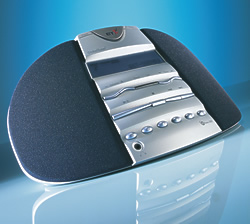While digital music files such as MP3 and Widows Media Audio (WMA) are popular for playback on portable MP3 players and personal computers, CD players and radios still reign supreme in family rooms, kitchens, and bedrooms.
At CES 2003, Onkyo demonstrated the new NC-500 Net-Tune Client, a compact stereo system that unites high fidelity sound with home PC networking, to deliver MP3 music to any room in the house.
Onkyo is positioning its Net-Tune® technology as an easy-to-use home audio network that delivers audio from PCs and digital media files to hi-fi stereo and home theater systems.
Net-Tune is available as a compact ‘stereo receiver’ component, the NC-500, priced at $400 (US) by itself, or $500 (US) in a compact stand-alone package with speakers. Net-Tune capability is also provided on the Onkyo TX-NR900, a full-featured 7.1-channel home theater receiver ($1,500 US).
To audio enthusiasts, the Onkyo NC-500 is a compact ‘stereo receiver.’ Computer networking people will call it a network ‘client’ device. Either way, it connects to standard wired or powerline Ethernet local area networks (LAN), which are becoming increasingly popular with consumers to simultaneously connect multiple home PCs to the Internet. Onkyo’s Net-Tune searches your home network to access MP3 files stored on family PCs or to play streaming Internet radio stations arriving at the PC through a high-bandwidth DSL or cable modem.
Up to 12 NC-500s can independently access music on the network at the same time without interfering with each other. Each person can listen to the same or different music as others on the network, selecting songs by album, artist, genre, or playlist.
With millions of homes adding broadband DSL and cable modems, consumers are adding home Ethernet networks so everyone in the house can go on-line simultaneously. As these networks expand, Onkyo Net-Tune products can plug into these networks, giving consumers even more benefit from their networks.
The Onkyo NC-500 has connections for an external CD player and includes a built-in AM/FM radio. It can also be used as a source component with outputs for delivering music from the network to a conventional stereo receiver.

 A virtually unknown UK-based company, Promotion & Display Technology (PDT) has done a great deal to build its international reputation with the launch of the first portable Internet radio, the InTune 200, at CES 2003 in Las Vegas.
A virtually unknown UK-based company, Promotion & Display Technology (PDT) has done a great deal to build its international reputation with the launch of the first portable Internet radio, the InTune 200, at CES 2003 in Las Vegas.